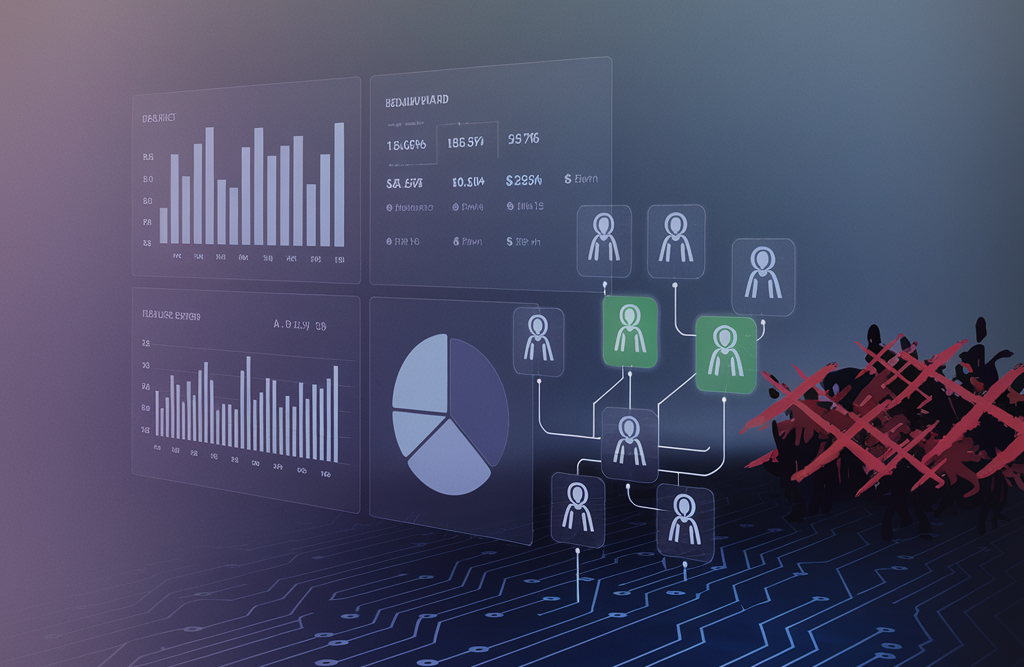Blogs Using AI Business Agents to Profitably Rightsize : Data-Driven Strategies Over Blanket Headcount Re-alignments
Using AI Business Agents to Profitably Rightsize : Data-Driven Strategies Over Blanket Headcount Re-alignments
Discover why blanket headcount re-assignments harm profitability and learn how AI-driven, data-informed strategies can enable smarter workforce optimizations to protect your bottom line.

The High Stakes of Headcount Management
When faced with the difficult decision of realigning headcount to preserve profitability, many companies resort to blanket percentage reductions across departments. While straightforward, this approach often damages high-performing teams and critical business functions, harming profitability long-term.
The real challenge is accurately mapping data to inform these decisions. Many companies struggle to connect workforce metrics to financial outcomes due to siloed data, outdated systems, and a lack of integrated analytics.
This guide explores how organizations can overcome these challenges and adopt data-driven strategies for profitable workforce alignment.
Challenges in Mapping Data to Your Business Model
-
Data Silos
Workforce data often resides in systems separate from financial data, creating fragmented insights. This lack of integration hinders organizations from making decisions that align workforce reductions with profitability. -
Lack of mapping data to day-to-day business operations
Lack of mapping data to day-to-day business operations -
Outdated Reporting Systems
Many businesses rely on manual reporting tools that don’t offer real-time data or truly map the data to business execution. Delayed insights lead to reactive decision-making, making it harder to achieve strategic cost optimization.
Data-Driven Strategies for Smarter Headcount Reductions
-
Align Workforce Re-alignment with Profitability KPI’s
Focus on protecting high-performing teams and revenue-generating units. Evaluate areas with less direct impact on profit for potential headcount re-alignment, instead of across-the-board reductions. -
Use Predictive and Modeling Analytics for Smarter Decisions
Predictive analytics can simulate the impact of lessening headcount, helping leaders determine which will have the least impact on productivity and revenue. -
Implement a Targeted Approach
Rather than curtailing headcount indiscriminately, identify specific roles or functions that can be re-assessed without harming operational efficiency and minimizing impact to ROI. -
Redeploy Existing Talent
Reassign employees to high-growth areas of the business to preserve institutional knowledge and reduce the need for rehiring when the market rebounds. Re-train employees from low growth areas to high growth skills areas with AI based Skills training journeys. -
Prioritize Long-Term Gains Over Short-Term Fixes
Avoid quick decisions that compromise critical talent and lead to higher long-term costs, such as lost productivity and expensive rehiring processes.
How AI Business Agents Help Optimize Reductions
Lemmata: The AI Business Agent Solution
Lemmata is an AI-driven platform designed to optimize headcount alignment through real-time insights. By aggregating and cleansing data from over 250 sources, Lemmata maps workforce impacts directly to business drivers, enabling leaders to make informed and profit-based decisions.
Key Features Include:
-
Impact Canvas Map: Maps business roadmaps to strategic goals and OKR’s, visualizing your business's operating model.
-
Custom Real-Time Dashboards: Real-time insights and scenario modeling help evaluate headcount changes by department, location, or product line.
-
Actionable Insights: AI tools pinpoint where re-alignment can minimize risks while maintaining profitability and driving Key Results.
Conclusion
Re-Balancing Headcount With Long-Term Profitability.
Curtailing headcount expenses is never easy, but a data-driven approach minimizes negative impacts on profitability, morale and positions organizations for future growth.
By leveraging predictive analytics, protecting core and strategic functions, and utilizing AI-driven tools like Lemmata, leaders can navigate workforce re-alignments strategically and profitability.
This approach ensures that headcount management support—not hinder—long-term business objectives and KPI’s.
For organizations to maximize the benefits of these technologies, they must integrate them effectively to enable comprehensive, real-time decision-making.
Frequently Asked Questions (FAQs)
-
Why are blanket workforce reductions ineffective?
Blanket reductions harm profitability by reducing high-performing teams and essential business units, weakening core operations and company morale. -
What is the role of predictive analytics in headcount modeling?
Predictive analytics models the strategic and profitability impact of headcount allocations, enabling data-driven decisions that maximizes productivity and revenue. -
How do AI business agents like Lemmata assist headcount allocation?
AI agents analyze the aggregated workforce and financial data, offering real-time insights into cost-saving opportunities that minimize impact to company level KPI’s around roadmap execution while protecting critical business functions. -
Why is talent redeployment important?
Redeploying employees to high-growth areas retains institutional knowledge, reduces rehiring costs, and strengthens underperforming business units. -
How can companies balance cost reductions with long-term growth?
Predictive analytics and AI tools safeguard essential resources while aligning reductions with profitability contributions.